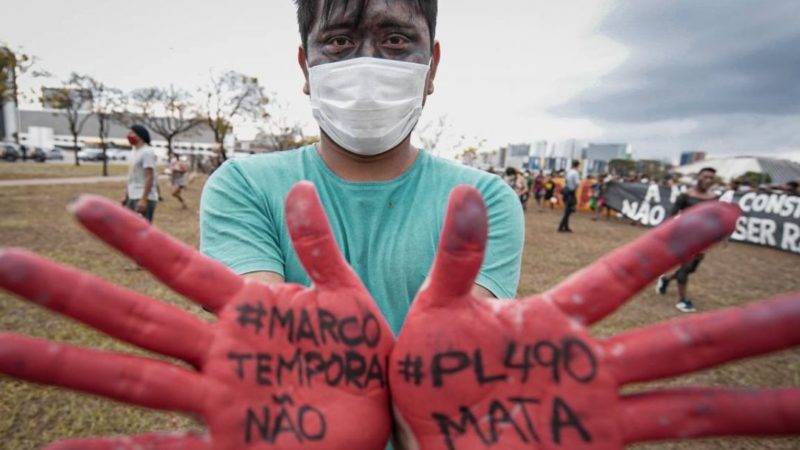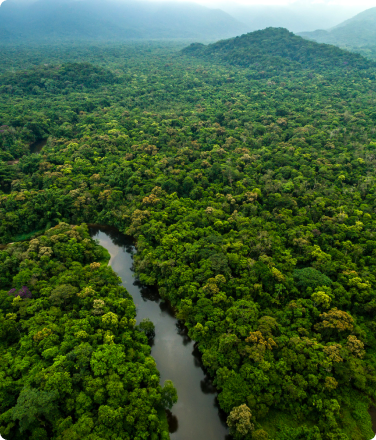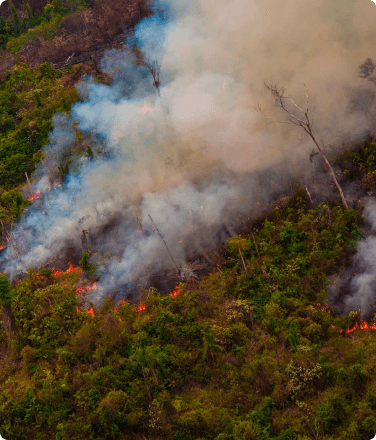Indigenous peoples from across Brazil came together in June to protest PL 490 and Marco Temporal. IMAGE CREDIT: APIB
They came from thousands of miles away, from all corners of the nation. They were many peoples: the Munduruku, the Macuxi, the Yanomami, the Pataxo. But they joined together this week in Brazil’s capital, thousands strong, many adorned in feathered headdresses and body paint, to speak in unified opposition to a bill that—if passed—will be the greatest setback to indigenous peoples’ rights in Brazil in a generation.
The protests come on the heels of similar demonstrations in June. Those protests ended with riot police firing tear gas and rubber bullets at the demonstrators, dispersing them. Ultimately, the demonstrators’ impassioned stand deterred lawmakers from voting on the bill, leaving its legislative fate hanging in the balance.
The passage of the bill—PL 490—could lead to a reversal of land recognition for indigenous territories throughout Brazil. By fundamentally changing the governmental process of recognizing indigenous territories—and by applying the revised process, retrospectively, to existing titled territories—PL 490 “could undo decades of work,” says Christine Halvorson, Program Director for Rainforest Foundation US.
Meanwhile, it proposes provisions that could open indigenous peoples’ lands to destructive extractive industries, something far-right president Jair Bolsonaro has long expressed sympathy for.
Now, as Congress once again considers PL 490 and a raft of other anti-indigenous and anti-environmental bills, the Supreme Court is simultaneously hearing a landmark case with enormous ramifications for the land claims of indigenous peoples in Brazil. The lives, cultures, and very future of indigenous peoples across Brazil are at stake.
The fate of the Amazon rainforest is undeniably, inextricably linked to the land rights of indigenous peoples. The rainforests under the stewardship of indigenous peoples are critical to the fight against climate change. In Brazil, these forests are estimated to store 39,315 million tons of carbon. The destruction of these forests would release into the atmosphere the equivalent carbon to 31 years of driving from all the world’s passenger cars.
Indigenous peoples have long faced an uphill battle to protect the country’s forests–and themselves–from threat. Indeed, calls for support by Brazil’s indigenous peoples were the catalyst that led to the establishment of the Rainforest Foundation in 1989. Twenty three percent of the Amazon is demarcated as indigenous lands thanks to the longstanding efforts of indigenous peoples. They have remarkably lower deforestation rates than elsewhere. But as much as the global community recognized the role of rainforests as the ‘lungs of the earth’ then, scientists now recognize their role (and therefore that of indigenous peoples) is much more consequential, with the trees serving as an integral countervailing force to the greenhouse gases that are warming our planet.
A Paralyzed Demarcation Process
Amongst the many problems that PL 490 will set upon indigenous communities, one of the potentially most harmful is how it could halt new federal recognition of indigenous territories.
As currently enshrined in the constitution, indigenous peoples have a distinct right to their lands under their recognized collective rights as indigenous peoples. The federal government must then take steps to determine the boundaries of their lands, an administrative procedure handled by the National Indian Foundation (FUNAI), the federal agency responsible for overseeing the government’s engagement with indigenous peoples that operates within the Ministry of Justice in the government’s executive branch. The process of recognizing indigenous territories in Brazil ultimately ends with ratification via presidential signature.
Demarcation is arduous and slow. For Raposa Serra do Sol, a 6,730 square mile (1.7 million hectare) indigenous territory in Brazil’s northern Amazon, ratification was only granted after over 30 years of struggle. In the last 20 of those years, Rainforest Foundation US supported the Indigenous Council of Roraima (CIR) in their legal filings, helped lead a public pressure campaign on the president to successfully secure his signature, and protected indigenous leaders who were put at risk for participating in the struggle. The successful demarcation of Raposa Serra do Sol eventually led agricultural lobbyists to first introduce PL 490, in 2007.
PL 490 would make what has already been a long process even slower and more difficult. Demarcations would require approval by Congress, threatening to leave new land demarcations in political gridlock and at the mercy of political decisions.
The Tricky “Time Frame” Loophole

Further encumbering the recognition of indigenous peoples’ land rights, PL 490 would codify the “Marco Temporal”, or “time stamp,” from which indigenous peoples can lay claim to a piece of land. Under PL 490, to claim land, an indigenous people must have been occupying it on October 5, 1988 (the day that Brazil’s constitution was established). The Marco Temporal would be a trojan horse for land theft. In 1988, Brazil was just coming out of decades of dictatorship, during which many indigenous peoples were evicted from their lands. And of course the forced expulsion of indigenous peoples from their territories predates 1988.
By way of example: the Guarani of the midwestern state of Mato Grosso do Sul have been marginalized and evicted by large agricultural interests since the 1930s. For decades, the Guarani have been seeking federal recognition of their lands, but the Marco Temporal provision would nullify their legal claim to lands they traditionally occupied prior 1988 if they were not on them on October 5, 1988. The fact that they had been removed from centuries’ old villages and sacred sites through that time and into the 1980s, wouldn’t matter.
And because all indigenous territories must comply with the bill’s proposed ratification process, all indigenous territorial boundaries will be vulnerable to remapping.
“The bill basically says that if you did not follow the exact process we laid out in this bill, you are subject to review,” says Halvorson. “Which means all indigenous territories could suddenly be up for annulment, with the lands openly accessible to those contesting the original claims.”
Extractive Industries
PL 490 isn’t just going to weaken the recognition of indigenous territories. It could also embolden profiteering outsiders to destroy rainforests on indigenous peoples’ lands. The Brazilian Constitution allows for the collective, permanent use and enjoyment of their territories by indigenous peoples. As such, they can’t rent or sell their land to outsiders.
PL 490 would allow indigenous peoples to lease their land, and the lessees could then do whatever they wish on the territory.
Such a potentially lucrative (and environmentally destructive) process is bound to be exploited by outsiders. “Big Agriculture wants to rent these lands. So who benefits from that rental?” Halvorson asks. Experts estimate that the conversion of forest to cattle pasture is the primary driver of deforestation in Brazil, with 63% of deforestation tied to the agricultural practice.
Between 2016 and 2018, deforestation–most of it illegal, without communities’ knowledge–rose 150% in indigenous peoples’ territories in Brazil. If land rental is legalized, those numbers are bound to increase further.
Next Steps
As the streets of Brasilia heat up in opposition to PL 490, Rainforest Foundation US has supported our partners’ mobilization efforts, ensuring a critical mass from the ground is there to have their voices heard.
The makeup of Congress suggests that, if put to a vote, the bill would pass and go to far-right President Jair Bolsonaro, who has signaled support for the legislation.
The bill poses an existential threat: not only to the indigenous peoples of Brazil, but also to the health of the climate worldwide. There’s growing evidence which shows that indigenous peoples protect rainforests better than state entities like national parks services, and indigenous peoples in Brazil see two-thirds less deforestation on their territories when their land rights are fully recognized. With the release of a United Nations report in August stressing the urgent state of climate change, it’s of paramount importance that we protect the rainforests that remain, including the 444,000 square miles (115 million hectares) of the Amazon which fall under the purview of Brazil’s indigenous peoples.








